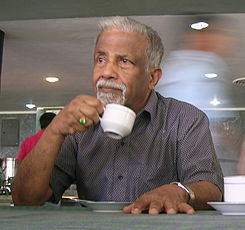E. C. George Sudarshan
George Sudarshan | |
|---|---|
 E. C. G. Sudarshan at TIFR Mumbai in 2009 | |
| Born | 16 September 1931 |
| Died | 14 May 2018 (aged 86) |
| Alma mater | CMS College Kottayam Madras Christian College University of Madras University of Rochester |
| Known for | Optical coherence Sudarshan-Glauber representation V-A theory Tachyon Quantum Zeno effect Open quantum system Spin-statistics theorem |
| Awards | ICTP Dirac Medal (2010) Padma Vibhushan (2007) Majorana Prize (2006) TWAS Prize (1985) Bose Medal (1977) Padma Bhushan (1976) C. V. Raman Award (1970) |
| Scientific career | |
| Fields | Theoretical physics |
| Institutions | University of Texas at Austin Indian Institute of Science Institute of Mathematical Sciences, Chennai Harvard University University of Rochester Tata Institute of Fundamental Research |
| Doctoral advisor | Robert Marshak |
| Doctoral students | Mohammad Aslam Khan Khalil Narasimhaiengar Mukunda |
Ennackal Chandy George Sudarshan (also known as E. C. G. Sudarshan; 16 September 1931 – 14 May 2018)[1] was an Indian theoretical physicist. He was a professor at the University of Texas at Austin.
Sudarshan was known for his works to the field of theoretical Physics including Optical coherence, Sudarshan-Glauber representation, V-A theory, Tachyons, Quantum Zeno effect, Open quantum system, Spin-statistics theorem, non-invariance groups, positive maps of density matrices, quantum computation among others.
His works include also relations between east and west, philosophy and religion.
In 2005, the Nobel Committee controversially did not award Sudarshan the Nobel Prize in Physics yet awarded his work about Glauber–Sudarshan P representation to Roy J. Glauber only.[2]
References[change | change source]
- ↑ Acclaimed scientist ECG Sudarshan passes away in Texas
- ↑ Zhou, Lulu (December 6, 2005). "Scientists Question Nobel". The Harvard Crimson. Archived from the original on 2012-04-25. Retrieved 2008-02-22.
